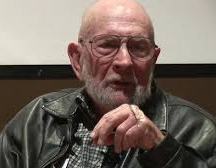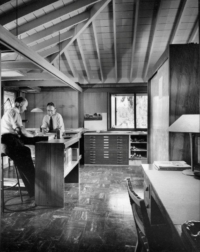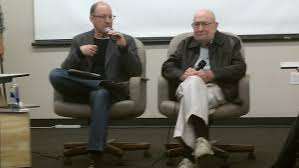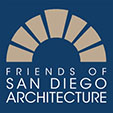The Roots of Architects Mosher Drew
Editor’s Note: The following account has been taken from “The History of Architects Mosher – Drew – Watson – Ferguson,” written by Robert Mosher himself, in the third-person. It preserves not only the history of the firm, but also an invaluable record of the relationships and influences within Southern California’s architectural community in the 20th Century.
Part One: The Origins of an Architect
 John Robert Mosher was born on September 27, 1920 in Greeley, Colorado. However, at an early age his parents, Jack and Alice Mosher, moved their family to Los Angeles, where Robert attended The Art Center School, and then, for two years, the University of Southern California, where he majored in architecture. In his junior year he transferred to the School of Architecture at the University of Washington, in Seattle, where he remained until he was drafted into the Army, just six months short of graduation.
John Robert Mosher was born on September 27, 1920 in Greeley, Colorado. However, at an early age his parents, Jack and Alice Mosher, moved their family to Los Angeles, where Robert attended The Art Center School, and then, for two years, the University of Southern California, where he majored in architecture. In his junior year he transferred to the School of Architecture at the University of Washington, in Seattle, where he remained until he was drafted into the Army, just six months short of graduation.
During his teen years, Mosher had lived across the street from the architect, Harold C. Chambers, who became a close friend of the family. Chambers was the partner of Myron Hunt, who, as a young man in Chicago, was member of an architectural atelier established by Frank Lloyd Wright. Irving Gill, who like Hunt, came to Southern California around 1892, was also a member of Wright’s atelier. Within a short time, however, both men left the group to seek their fortunes in the West: Gill to San Diego and Hunt to Los Angeles.
In early 1944, Mosher was discharged from the Army with a medical disability. He then re-entered the University of Washington, six months later received his Bachelor of Architecture degree, and returned to Los Angeles. Because there were few civilian architectural jobs, he joined the Myron Hunt and H. C. Chambers firm of his old neighbor, Harold Chambers. The firm was engaged in a large volume of work for the U.S. Navy and Marine Corps, had completed the design and building of Camp Callan in La Jolla, and begun on Camp Pendleton in Oceanside. It was there that Mosher came to know Myron Hunt, to fall under his spell, to admire him, and to learn from him. Both Mosher and Drew give credit to Mr. Hunt for his architectural mentoring. Both men felt that Myron Hunt and Harold Chambers contributed to their sense of purpose and direction and, much later, realized what a happy coincidence it was that working for the firm brought them together in the spring of 1946.
During this time, and while studying for his architectural examinations, Mosher left to join Harwell Hamilton Harris, a leader in the then new and exciting Modernist movement in Southern California. He was a graduate of Pomona College, with a degree in art. An artist-turned-architect, he never achieved registration in California, due in part to not having graduated from an accredited school of architecture. Prior to opening his own office, he had worked with Richard Neutra and Rudolph Schindler, where he refined his ideas and found his voice. Mosher was only in the Harris office eight months, but, as a result of his experiences with Myron Hunt and Harwell Harris, he realized that the training and point of view he acquired at the University of Washington was valid and worthy of serious pursuit. He also credits Harris with being the principal influence which shaped his design philosophy and gave him strength of conviction which stayed with him throughout his professional life.
But knowing he needed three more months with a registered architect in order to take the State Board exams, he reluctantly left Harris and accepted a position with Paul Haynes, who was registered and, like himself, had worked for Hunt and Chambers. In 1946, Mosher and Drew had not yet met, but their paths were soon to cross as a result of their mutual friendship with the Hunt and Chambers alumnus, Haynes. Haynes told Mosher when he hired him that he had “this great Yale graduate, Roy Drew,” joining them too, and that he, Haynes, would be principal, Drew would be the senior draftsman, and Mosher would be the junior draftsman. It was then that Robert Mosher and Roy Drew’s friendship began – a friendship that would thrive for more than fifty years.
One day, during his stint in the Haynes office, Mosher announced that he had completed his preparation for the architectural exam and would be leaving to return to La Jolla. Drew could not believe it. “You mean to tell me that you’re leaving his great city, with all its potential, to go to that foggy beach town?” That was the decision, and Robert moved to San Diego in the spring of 1946, where he joined the firm of William Templeton Johnson. After only six months with Templeton Johnson, Mr. Johnson invited Mosher to become a junior partner and, flattered, he accepted. Johnson was a dignified and gracious man who made every effort to make Mosher feel welcome and a part of his practice. However, the atmosphere and personnel in the office, and the nature of the work, were not in harmony with Mosher’s objectives and ideals.
Then, quite suddenly, an opportunity arose. One of San Diego’s leading citizens, the construction company founder, Roscoe “Pappy” Hazard, announced that he was going to build a new house and was looking for an architect. Through a friend, interior designer Ross Thiele, Mosher was recommended for the commission. It was the chance to open his own office in La Jolla and he took it.
Earlier in 1944, Mosher’s father, Jack, retired and bought a commercial property in La Jolla known as the Green Dragon Colony. At the time the Hazard house design offer came, Robert was in the process of designing a new commercial building at the Green Dragon Colony, which included second floor office space – a perfect solution for an office. [ Editor: the office, 1262 1/2 Prospect Street in La Jolla Village, is shown in photo below.]
By that time, there was a deluge of new construction starting up due to the building vacuum produced by the Great Depression and World War II. It was a good time for a young architect to start a practice, but there was a serious shortage of qualified help available. Mosher found himself in a difficult position as several other commissions soon became available with no one to assist him in getting these projects underway.
Would his friend Roy Drew, with whom he shared architectural and ethical values, and for whom he had great respect, consent to leave Los Angeles and come to the “foggy beach town?” Drew accepted an invitation to come for a six month trial period, but the two would eventually form an equal partnership and pursue the practice of architecture as they had always hoped it could be practiced. A few months later, on May 15, 1948, the firm of Mosher and Drew Architects was formed.
Part Two: The Growth of the Firm
 During the first seven years, the fledging firm grew slowly, acquiring several distinguished clients, including Gordon Gray, of the law firm Gray, Cary, Ames and Fry; James Copley, the publisher of the San Diego Union and Tribune, and Mr. and Mrs. Herbert Kunzel. In 1950 Kunzel was a lawyer representing The Solar Aircraft Company and a respected civic leader. In later years, he became Solar’s President.
During the first seven years, the fledging firm grew slowly, acquiring several distinguished clients, including Gordon Gray, of the law firm Gray, Cary, Ames and Fry; James Copley, the publisher of the San Diego Union and Tribune, and Mr. and Mrs. Herbert Kunzel. In 1950 Kunzel was a lawyer representing The Solar Aircraft Company and a respected civic leader. In later years, he became Solar’s President.
These contacts, together with the partners’ interest in working with civic groups and community leaders, led to many desirable commissions and helped to establish the firm as a responsible member of the community.
The new partners established their practice in the office space in the Green Dragon Colony which Mosher had designed for himself and his father, Jack, the year before. Jack Mosher shared these offices with Robert and Roy, and served as their accountant and bookkeeper for nearly eighteen years.
For Robert, 1955 marked a significant turning point in his career. In 1951, he had designed a house for Mr. and Mrs. Herbert Kunzel, and in late 1954, the house came to the attention of Ellen Sheridan, the Southern California editor of Sunset Magazine, who had taken an interest in the partnership and published fragments of a number of its projects. (Sunset, at that time, restricted its coverage to publishing details of houses, in contrast to other shelter magazines which featured complete projects.)
Surprisingly, Mrs. Sheridan declined the Kunzel house, saying that it should be published by House Beautiful Magazine. This generous gesture led to the firm’s introduction to the architectural photographer, Maynard Parker, who photographed the house on speculation, a procedure he had seldom before undertaken.
Ellen Sheridan sent the photographs to Elizabeth Gordon, the editor of House Beautiful Magazine. The project was subsequently accepted by Miss Gordon for publication, which set into motion a series of events which had a profound effect on Robert’s life. Mosher and Drew had previously agreed, upon the formation of their partnership, that one of the benefits of their arrangement was that either of them could take a leave of absence, during which time the other would manage the firm. When Miss Gordon suggested that if Robert would come to work for her in New York for two years, it would enable him to see America and he would be half-way to Europe, Robert accepted without hesitation. Two months later he, his wife and their two small children were on their way to New York City.
House Beautiful, at that time, in addition to its Editor, Elizabeth Gordon, had a remarkable editorial staff, who shared Gordon’s dedication to humanist architecture. Robert joined the compatible group as Building Editor, and wrote the “Nature of Materials” article for the first publication of the work of Frank Lloyd Wright in a “shelter” magazine. To prepare for this, he, along with Miss Gordon, and other editorial staff from the magazine, spent two weeks with Mr. Wright at Taliesin East, in Spring Green, Wisconsin.
The experience was remarkable. Morning, noon and night, in the presence of this great man, listening to his ideas, expressed with clarity, was, for a young person with little exposure of this kind, like opening the door to a world only dreamed of. This was the beginning of a period of growth and broadening of vision from which Robert profited for the rest of his life.
From his New York base, Robert traveled extensively throughout America, meeting many of the leading people in design; he did extensive writing; and, was able to fulfil his dream to travel to Europe. His New York tenure was all he could possibly have hoped for. After two stimulating years, Robert and his family returned to La Jolla, refreshed and ready to resume their Southern California life. His outlook had been permanently altered.
The year 1958 marked a significant change in the types of commissions the partners obtained which also necessitated new offices with the only available site on top of old concrete garages on the lower portion of the Green Dragon property on Coast Boulevard. While the space was adequate, the view of the ocean and north shore was sensational.
Between 1958 and 1968, in addition to the residential work which was the basis of the early practice, they were retained for larger projects. For Robert, projects included the first and second additions to the La Jolla Art Center (later to become the La Jolla Museum of Art); the Married Students Apartments, the Residential Apartments Phase Two, the Master Plan for John Muir College and the Applied Physics and Mathematics Building at the University of California, San Diego; the Aztec Center (Student Union) at San Diego State University; the San Diego Fine Arts Gallery, West Wing (now the San Diego Museum of Art); the Bank of La Jolla Building (now the Wall Street Building); All Souls’ Episcopal Church in Point Loma; the Kellogg West Conference Center at California Polytechnic University, Pomona; the Golden Valley Office Complex in Mission Valley; and, the Sherwood Auditorium, expanded galleries, and a new entrance for the La Jolla Museum of Art (now the Museum of Contemporary Art, San Diego). During this period, Robert also served as Design Consultant for the San Diego/Coronado Bridge.
Early in 1968, with the business continuing to grow, both Robert and Roy realized that, with their interests centered on design, they were more and more inclined to let the management of the firm take second place in their attention. They resolved to find a third partner and chose an old friend from San Francisco, William Watson. With a BA degree from Princeton and a Master of Architecture from Harvard, Watson joined the Navy in 1941 and was discharged in 1946 with the rank of Commander. His background included two stints with Skidmore Owings and Merrill, once in New York and again in San Francisco, and later in the office of Anshen + Allen. Watson immediately took charge of the management of the firm and successfully controlled it until his retirement in 1986.
In 1960, a young man from Montana, William Ferguson, joined the firm and through the years, became a valued member of the staff. Having served in the Navy, after graduation for the University of Colorado, Bill returned to San Diego after working in the Omaha, Nebraska offices of Leo A. Daly. During the period from his first employment to his being made a partner in 1972, his character and professionalism become self-evident. He worked closely with Robert on many of the same projects, including the Central Federal Tower (formerly NBC Tower in downtown San Diego), as well as the University of California, San Diego, Medical Teaching Facility.
In returning to many of the design principles expressed in his earlier residential projects, one of Robert’s most beloved projects is the Golden Door spa in north San Diego County. The project was inspired by a visit with the client to Japan and the resulting buildings, including their placement in the landscape, provide a clear testimony to the reinforcement of those principles, as they draw upon his earlier sensitivity to the human scale and appropriateness of natural materials. The overall effect, when integrated into the earth forms and other elements of water and gardens, has over the years proven effective in transporting the visitor to another place and time, removed from the modern world.
With various other housing, teaching, and research projects on the UCSD campus, plus some of the initial facilities on Torrey Pines Mesa (e.g. Spin Physics, a subsidiary of Eastman Kodak Company), Robert Mosher’s left his mark on San Diego. His legacy will remain as a testimony to his character, integrity, clarity of thought and design, but most of all his love for the community and culture that was his home for almost 95 years.
Epilogue:
Robert Mosher retired from the firm in the early 1990s. He passed away on July 26, 2015. Friends of San Diego Architecture had benefitted from his insight into the history of local architecture when he presented a program with Keith York during the 2011-12 lecture series. On January 21, 2012, the pair treated us to “Modernist Morning: A Chat with Robert Mosher and Keith York.”

